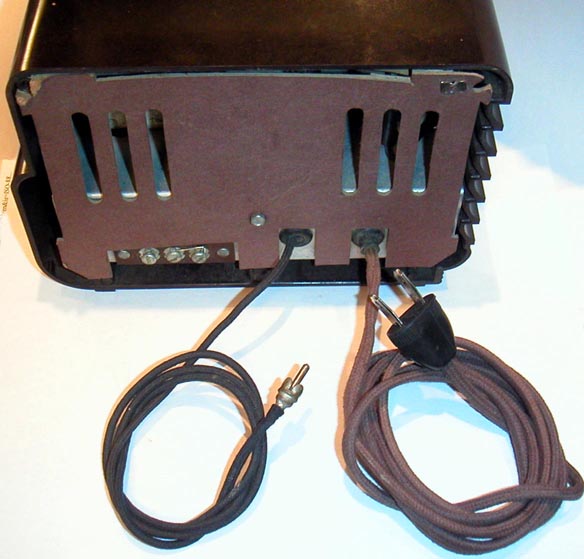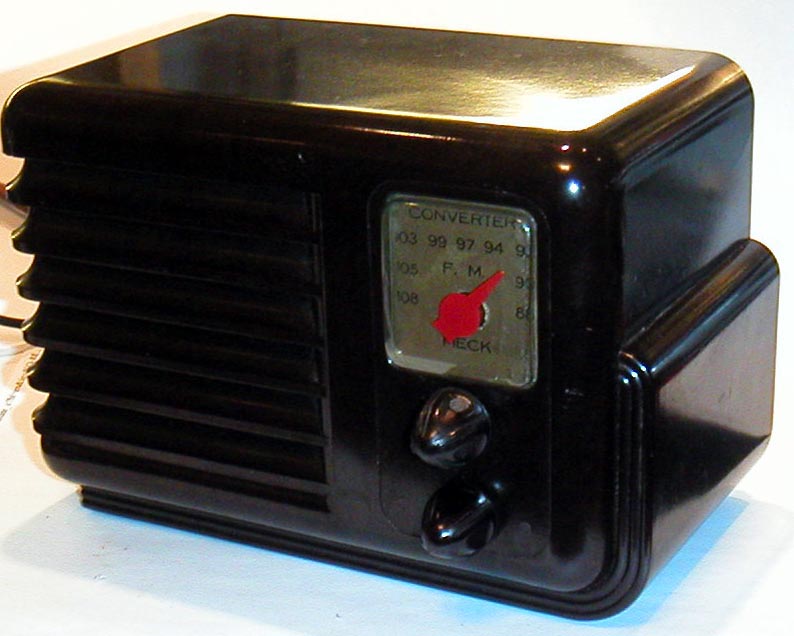meck: Fremodyne Restoration
meck: Fremodyne Restoration
Fellow Radiophiles,
After a long wait for an automated search on ebay for a Fremodyne FM tuner or radio, I found this Meck FM Converter.
This FM converter might best be understood as an FM tuner because there is no output AM modulator to feed to an AM radio, but there is a standard transformer isolated audio output feeding an RCA plug.
The construction of this single tube tuner is very simple. The handsome bakelite case has no mounting screws for chassis. The chassis is held in place by the two front knobs, one of which is for tuning and one is the power switch.
 There are two options for the input antenna connection. One is via an external 300 Ohm twin lead, and the other uses the power cord as the antenna, by strapping two screw terminals together.
There are two options for the input antenna connection. One is via an external 300 Ohm twin lead, and the other uses the power cord as the antenna, by strapping two screw terminals together.
The power cord was still pliable, and in very good shape, but the built-in heater resistor was open in several places.
I replaced the 450 Ohm power cord resistor with 3.5uF of capacitance in series with the heaters.
I used five K5U capacitors in parallel, with 0.68uf capacitance, each. I pretested the capacitor voltage breakdown to withstand 600VDC with my Heathkit IT28 capacitor tester. (Ceramic capacitors often can widstand far more voltage than they are marketed for. Often, the rated voltage for high K ceramic capacitors simply means the highest voltage that the capacitance tolerance is maintained. Above the rated voltage, the capacitance drops out of spec.)
The K5U capacitors appear as short stack of small blue capacitors soldered in parallel on the socket of the 35W4 power rectifier.
A 470k resistor should be added in parallel with the K5U capacitors to bleed stored charge.
I also added 0.2A slow blow fuse in series with the main power switch for added safety. This has become standard procedure for my radio restorations.
I left the original yellow dried-out supply bypass electrolytic in place, while adding two new electrolytic capacitors at the upper left, to replace the two dried up 40uF sections.
The 8uF electrolytic cap in the foreground had also dried up, so I added a 10uF 35V in parallel with this cap. It is located under the old cap.
Whenever possible, I like to leave the defective parts in place, and if leaky, I cut open one lead.
The yellow cylinder at the left is not a capacitor, but the RF transformer that couples the power cord to the front end, as an antenna, when terminals 2 and 3 of the antenna board in the foreground are shorted together.
Operation
The heart of this single tube FM tuner is the Fremodyne circuit. The Fremodyne is a variant of the Super-Regenerative FM detector. There are several references to Fremodyne operation within RMORG:
"Fremodyne" Superrgenerative Detector
FM Demodulators by Prof Dietmar Rudolph, in German, but could be read with Google-Translate.
Summarizing the operational highlights, the 14F8 loktal dual triode uses one triode as a conventional local oscillator operating 23.25MHz above the incomming signal, and the second triode as mixer and Super-Regenerative detector at the fixed 23.25MHz IF frequency. Sometimes the Super-regenerative detection is described as accomplishing the function of IF amplifier and FM slope detector. This is true too.
The chassis is tied to one side of the power line via the power switch, but a 3X step-up audio isolation transformer, delivers audio safely to the RCA plug.
Modifications
Originally, the self-quench frequency of the super-regenerative detector operated at 20kHz, and caused a lot of unpleasant frequency beats. The original detection slope was also too steep, and clipping distortion was heard on the louder passages.
The Rider alignment instructions describe R2=150k and C6=5nF as the primary determinants of the quench frequency, so I decided to experiment with R2 to increase the self-quench frequency to reduce beats with the FM stereo subcarrier.
These three shots show the reduction in quench frequency, as I reduced R2 from the original 150k to 36k. I experimented with a 47k resistor in series with a 100k pot. I settled on the 45kHz quench rate, as it seemed to have relatively low beat energy with the 38kHz stereo sub-carrier.
One drawback of this method of increasing quench rate is that it also alters the mixer bias for the super-heterodyne conversion, this in turn, reduced the sensitivity (SNR) somewhat.
Another effect also reduced the amplitude of the output signal by about 5X, as can be seen by the reduced duty cycle modulation of the quench frequency in the three shots above.
The effect is that the higher bias level provided by R2 made the initial regeneration time constant of the 23.25Mhz oscilations much faster. This initial regeneration time constant sets the conversion from the FM slope of the tank circuit to the duty cycle of the cathode current. A fast time constant modulates the duty cycle less.
After I was done fiddling with the circuit, I tuned in the strongest local station and listened to it for one evening with the quench rate around 45kHz. The sound was surprisingly good.
When using the power cord as the antenna, I was able to get only two stations in the Boston-Massachusetts metropolitan area. My roof antenna pulled in another 8 stations.
Perhaps the original tuner configuration would have worked well with relatively low FM deviation, and without an FM subcarrier.
Comparing to other FM super-regenerative radios
When compared to my Hastings FM Jr, the Hastings showed better sensitivity. This could be due to the direct super-regenerative detection that the Hastings uses at the incomming carrier frequency. The super-heterodyne conversion loss in the Fremodyne seemed poorer, but that could be due to my increase in bias at R2.
From a circuit analsys point of view, I would expect higher performance from the Schaub-Pirol 56WU. The Pirol is also an FM superhet radio with super-regenerative detection, using just a dual triode for FM, like the Meck.
However, the Pirol makes much better used of the second triode, by running it as an additive self-oscillating converter with gain, instead of just running it as the fixed LO in the Meck. This type of front end is often quite sensitive when used with full super-heterodyne designs. I own a Grundig Concert-Boy 57 with this type of additive front end converter, and it is quite sensitive.
I don't own a Schaub-Pirol 56WU yet. Perhaps some day...
When searching RMORG for the topic of Super-Regeneration, use the German word "pendler", which means commuter, and refers to the quenching action. Then Google-Translate can be used to read the German language text.
Regards,
-Joe
To thank the Author because you find the post helpful or well done.
Meck: Fremodyne Comparisons

Dear Colleagues,
Joe kindly asked me for some comments and comparisons between my Fremodyne and the Meck. For reference, I include the circuit diagram of the home made Fremodyne:

The main difference is in the de-emphasis circuit, so I can only listen directly with a crystal earpiece. The local oscillator runs below the signal frequency, so that the FM band occupies the entire tuning capacitor swing.
The quench frequency should be the same as the Meck's original 20 kHz. I never experimented with it.
I am situated about 15km from the FM transmitting tower, and the set receives most stations without an antenna. Subjectively, the set doesn't give a great deal of distortion - it would sound like any other FM receiver, if it weren't for the mains hum. (Maybe running the heater leads as tracks on a printed circuit board is not a good idea.) The hum is not very noticeable on strong stations.
I haven't noticed any interaction from the FM subcarrier - perhaps because I am in an area with such a high signal strength.
I did find that the set was quite fussy about its HT supply, and worked best with 80 Volts, with some distortion at 90 volts.
Perhaps one day, I will find a commercial Fremodyne.
Regards,
Bryce
To thank the Author because you find the post helpful or well done.
Distortion and regeneration
Dear Bryce, thank you very much for your contribution. It helps me get a sense of what to expect from my Fremodyne.
One thought comes to mind on distortion:
The horizontal jitter that can be seen at the second and third edges of the quench waves in the photos I posted above, represents the detected audio output.
It is fundamentally necessary that this time jitter be less than the regeneration time constant of the 23.25MHz IF oscillation bursts.
The photo with 36kHz quench rate shows a jitter on the order of 5us. This is far too much jitter!
The regeneration time constant is on the order of 1us, perhaps less.
No wonder the sound is so much sweeter with the higher quench rates.
When I increased the quench rate with a decrease in R2, I must have also lowered the detection slope, which resulted in the lower volume that I hear but, most importantly, got the detected jitter below the regeneration time constant.
In this type of self-quenched super-regenerator, the waveform of the quenched tube current may start low, with a resulting high Q and steep detection slope, and then increase to a higher level and a lower the detection slope. This means that lower level signals would see a steeper detection slope than stronger signals.
Hmm, perhaps I should put my Fremodyne back on the bench and measure the tube current profile, and the regeneration time constant of the 23.25MHz bursts and low and high levels.
By the way, I also noticed a sensitivity to supply voltage. The quench rate goes up at lower supplly voltages. I first noticed this when I turned the power off the sound would clean up, while the quench rate was set at the original rate. A variac confirmed the effect.
Thanks again, Bryce, for stimulating further thought.
-Joe
To thank the Author because you find the post helpful or well done.

